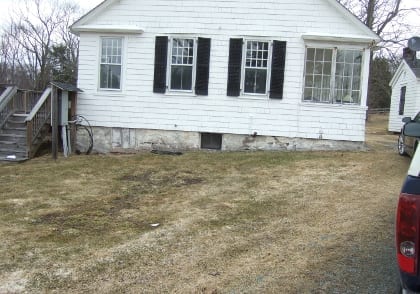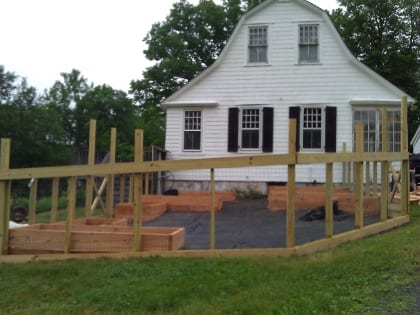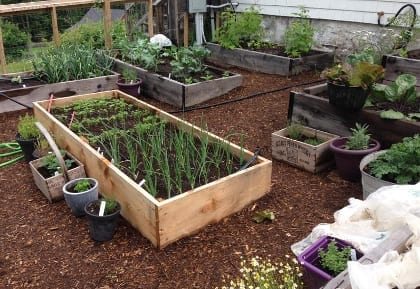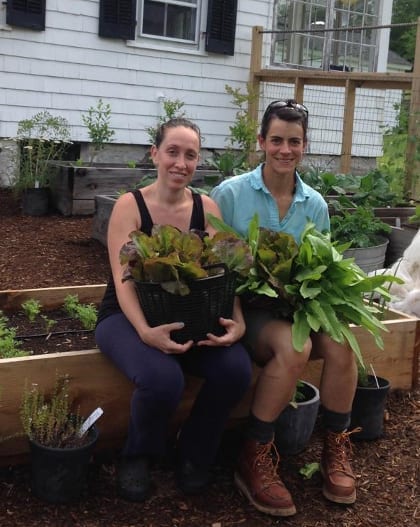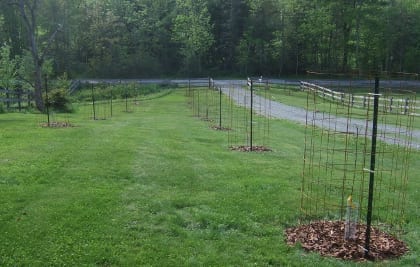by Adrianne Picciano
The majority of my vegetable garden installs consist of me designing, building, planting, and turning the finished product over to my client to take care of. Sound familiar? Every once in a while, however, a special person comes along who wants to be more hands-on, learn from me, and gain the skills to maintain their own gardens. For these people, I have created a special service, called Dirt Therapy, in which I work side by side with the client in the garden, performing seasonally appropriate chores, offering advice, and teaching all the while, with the eventual goal of the client flying solo. The service has taken off with my NYC second-home-owner clients, who are eager to get their hands literally dirty, grow their own food, and learn about the cycle of garden tasks in our Catskill climate.
I’m in year two of one such project, which keeps evolving as my client’s thumb gets greener. The first phase began in summer 2014, when I installed a 30’ x 30’ fenced raised bed veggie garden off the south side of their cottage. Although the property had many open sunny areas suitable for veggies, the location just off the house seemed the most practical, as the water source was right there, and my clients could keep a close watch on the plot at all times. The garden was sized to feed two part-time resident adults with occasional house guests on the weekends. After reviewing a spreadsheet of all the possible things to grow with the client, I narrowed down the options based on her must-haves, and took into account the limited bed space (192 sq ft). We included some perennials (blueberries, raspberries, and strawberries) with the balance in annuals (tomatoes, peppers, lettuce, arugula, carrots, beans, cucumbers, musk melons, pumpkins, onions, and garlic as well as annual flowers.)
Expanding Family, Growing Garden
This past spring, I built two additional 3’ x 8’ beds to allow for more growing space for their growing family. The garden is absolutely bursting with produce this year. My client is feeding house guests every weekend and even making some of her baby’s food from the garden. Insect pests and disease are kept at bay thanks to weekly Dirt Therapy sessions where she and I patrol the whole garden and nip threatening situations in the bud. Each week I am amazed at the health and productivity of this garden. I really believe in scaling a garden to a client’s availability and skill level. As one becomes more confident, the garden can increase in size.
For the majority of my veggie gardens, I opt for wood-framed raised beds (always 2” x 10” hemlock) filled with a 50/50 mix of screened, composted cow or alpaca manure and topsoil outfitted with a drip irrigation system on a timer. Pathways are only as wide as necessary (2’ to 3’) and are covered with a layer of woven black plastic ground cloth with client’s mulch of choice on top (straw, pea gravel, or bark mulch). Wood-framed raised beds contain the growing medium partitioned into easy-to-identify areas, and conjures up for many the memories of playing in a sandbox as a kid. It conjures up that memory for me for sure!
An Orchard Addition
This spring I also planted an orchard to coincide with the birth of my clients’ first child, and they are caring for the trees as if they were their babies – monitoring them on a daily basis, learning how to tell when they need water, food, and protection from the elements (insects). Although they take longer to bear fruit, I always opt for fruit trees in whip form, from either St. Lawrence Nursery or Fedco Trees in Maine, since I can be sure the varieties are winter hardy to the Catskills (zone 5a-b) and whips weather transplant shock better. This takes some explanation, as most clients are expecting something that looks like a tree to arrive, and not a 2’ long stick with some buds on one end and roots on the other.
Planting trees in Catskills’ “soil” is often a frustrating and laborious experience, and that was certainly true in this case. The orchard site is on ledge, with a hard shale-y mix in the upper foot of “soil.” To troubleshoot this, I hollow out a shallow bowl in the native soil with a pick mattock, (forget the shovel here) and mound up a mix of compost, bark mulch and the resulting native soil (which is mostly broken bits of shale), and planting the trees into these mounds. More bark mulch is used to create a circular berm around the trees to hold water, like a dish, so when the client waters, they know to fill up the dish to the top of the berm and let it soak in before moving onto the next tree. The trees are protected from rodents with hardwire mesh tree trunk wraps and from deer by 5′ x 10’ concrete reinforcement wire panels bent into a cylinder and staked with one metal Lug U-post. Now that we are in the heat of the summer, I can see all the trees have new growth and are weathering the attack of fungal disease and Japanese beetles relatively well for their size. Success!
Although I love the act of gardening, being outside and in sync with the seasons, the greatest thrill in my work is watching a newbie gardener’s eyes open to the world I know so well. I believe that once someone is introduced to the ways of gardening, the knowledge has a snowball effect, since it opens one up to the environment around them and shows that they are in fact part of it.
About the Author
Adrianne Picciano, AKA The Dirt Diva, builds, and maintains organic vegetable and perennial flower gardens, home-scale orchards, and edible landscapes for private and commercial customers in the Sullivan County Catskills and Upper Delaware River region. She has taught Master Gardener training modules through the Cornell Cooperative Extension of Sullivan County and has presented gardening workshops for the Northeast Organic Farming Association of NY (NOFA-NY) annual conference. She may be reached at dirtdiva79 @ gmail.com.

